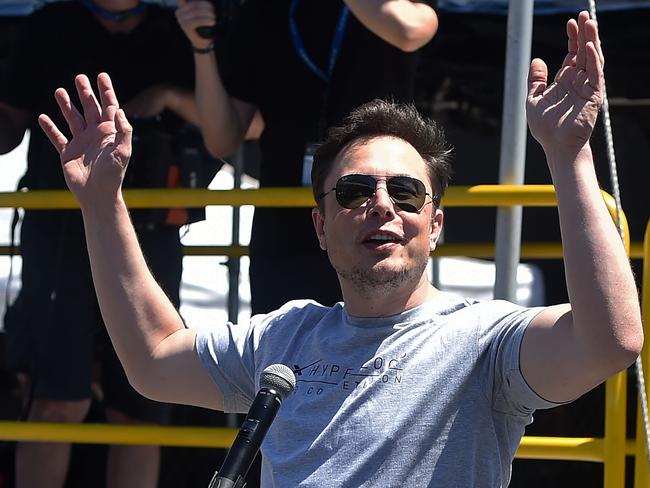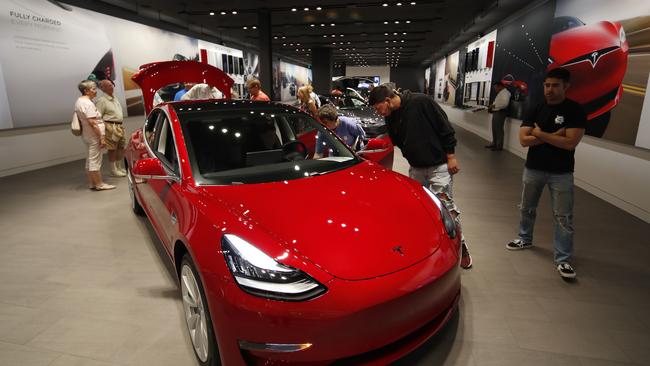Public bravado, private doubts: how Elon Musk’s Tesla plan unravelled
What happened after one Elon Musk tweet lit the fuse on an abortive, $US70bn scramble to take Tesla private.

The Tesla board convened on Thursday at the company’s factory in Fremont, California, in a conference room where Elon Musk often spent the night. His sleeping bag was still on the floor.
The agenda was Mr Musk’s audacious plan to take Tesla private, which he had sprung on the investment world 16 days earlier via tweets. He was joined in the room by board members, lawyers, bankers and advisers, members of a Wall Street transaction machine put into motion by the entrepreneur’s idea.
Mr Musk’s plan turned out more shaky than his tweets suggested. He had told the world he had funding “secured,” and one tweet elaborated that the deal was so certain it needed only a shareholder vote.
As the team hustled to put form to his idea, lining up investors willing to put up the tens of billions of dollars required for the deal, Mr Musk was having doubts, according to people familiar with this thinking.
A buyout, even if accomplished, would force some of the technology mutual funds that had been ardent supporters to trim their stakes. It might mean allowing competitors inside his tent — one of the investors his bankers had lined up was Volkswagen, people familiar with the matter said.
Taking Tesla private also would displace legions of small-fry stockholders — a merry band of electric-car fanatics willing to look past Tesla’s rickety finances and its struggle to master the skill of mass-producing cars. Taking their place would be more sophisticated investors tugging on a tighter leash.
Then there was the photo emailed to him last week from an elderly couple, dressed in Tesla T-shirts and baseball caps. The couple held up a handwritten sign congratulating Mr Musk for producing 7,000 electric cars in seven days. Their message: “Thanks, Elon! Two happy stockholders!”
Mr Musk forwarded the email to a friend. “Made my day,” he wrote. It also nagged at him.
In the conference room, bankers from Goldman Sachs and executives at Silver Lake, the private-equity firm brought in to try to facilitate a deal, made their presentation. Then Mr Musk rose to speak.
Taking Tesla private was an idea he mulled for years, and Wall Street was offering him the chance to try. Despite a meteoric stock-price rise — up 78 per cent since the end of 2016 — Mr Musk was obsessed with short-selling investors who bet on Tesla’s price declining. He complained about the scrutiny aimed at public companies, once chiding Wall Street analysts for asking “boring, bonehead” questions. Ever the optimist, he viewed Tesla as a revolutionary business with its best days ahead.
Then on Thursday, he told the board he wouldn’t be pursuing the deal.
The US Securities and Exchange Commission is now investigating his tweets about the deal, including the one saying he had “funding secured,” putting Mr Musk and the company in jeopardy.
Mr Musk’s task ahead is to try to bury his private-transaction dalliance and focus instead on mass-marketing the Model 3 sedan — a bet-the-company product — at a scale and cost that could make it a mainstream car. The company has significant debt obligations coming due over the next year, and some of its suppliers are nervous about Tesla’s ability to pay.

“In my opinion, the value of Tesla will rise considerably in the coming months and years, possibly putting any take-private beyond the reach of any investors,” Mr Musk said Saturday in an email to The Wall Street Journal. “It was now or perhaps never.”
This account is based on interviews with people involved in and familiar with the discussions and negotiations that stretched between Mr Musk’s first tweets and a blog post late Friday night that put a bookend on the deal.
Zero to 100mph
Mr Musk’s August 7 tweets kicked off a frenzy of how-the-heck speculation about a going-private transaction that valued at $US70 billion — Mr Musk had offered $US420 per share — a company that had never made an annual profit.
He hired a conventional set of deal advisers, including bankers from Goldman, and lawyers from Wachtell, Lipton, Rosen & Katz.
Am considering taking Tesla private at $420. Funding secured.
— Elon Musk (@elonmusk) August 7, 2018
Fund managers including Fidelity Investments, a longtime booster of Mr Musk’s tech empire, couldn’t roll its entire stake into a private Tesla, because of regulatory constraints, said people familiar with the matter.
Each investor that didn’t stay with Tesla needed to be bought out. Weighed down with debt and bleeding cash, the company would be hard-pressed to borrow more. Mr Musk needed new shareholders.
In an August 13 blog post, Mr Musk cited Saudi Arabia’s sovereign-wealth fund as the source of his secured funding: “Obviously, the Saudi sovereign fund has more than enough capital needed to execute on such a transaction.”
That rankled some senior officials in the kingdom, according to people familiar with the matter. Prince Mohammed bin Salman has big ideas to turn his petrostate into a technology and solar-power hub as part of his plans to develop its economy. And he was interested enough in Tesla to consider being part of a take-private transaction; the Saudis had already bought a near 5 per cent stake in Tesla in the public market. But the Saudis never made a formal proposal. A Saudi government official and an adviser familiar with the talks said the country’s senior leadership was divided.
Mr Musk’s tweets and the blog post didn’t help. The government official said his behaviour worried some officials about his health as well as the role he would play in the company.
They also fretted about the expense: The Saudi sovereign-wealth fund was already weighing an investment in a Tesla competitor, and the kingdom has grandiose plans that include a massive new city in the desert.
For Tesla, Saudi Arabia wasn’t a perfect fit either. Protective of its image as an environmentally friendly company that built cars in the US, some at Tesla complained to Mr Musk about selling a large interest to a foreign oil producer.
That left Mr Musk’s bankers casting around for others: car companies, sovereign-wealth funds, anyone who might take a strategic interest in Tesla — or who would be willing to make a big bet.
Machine in motion
Despite his over-the-top public persona, Mr Musk keeps close counsel. A key group of Tesla executives have been at his side for years, including Chief Technology Officer J.B. Straubel; General Counsel Todd Maron, who once was his divorce lawyer, and finance chief Deepak Ahuja, who returned to the company last year after retiring from the same role in 2015.
Tesla’s board recently added independent directors James Murdoch and Linda Johnson Rice but is still dominated by Mr Musk’s longtime supporters, including his brother, Kimbal Musk, a close confidant.
Mr Musk had spoken in recent years to Michael Dell, the founder of Dell Inc., who had taken his own company public, then private a quarter-century later and then public again, according to a person familiar with the discussion.
Once Mr Musk raised the idea of a transaction, he expanded his advisers beyond his West Coast loyalists. He hired Egon Durban of Silver Lake Partners, who had brokered and helped bankroll the Dell buyout. Gregg Lemkau and Dan Dees of Goldman came on board, too, to advise Mr Musk and tap the firm’s connections to wealthy investors around the world.
By Saturday, August 18, the deal machinery was fully in motion. The Tesla board held a meeting by telephone, with Mr Musk and his brother Kimbal huddled in Los Angeles.
Mr Musk presented ideas about how a transaction could be structured. When asked about his earlier promise that individual investors would be able to join, he acknowledged it might not work, according to people briefed on the discussions. The meeting ended on a positive note, though, one of the people said, with most directors believing Mr Musk remained committed to the idea.
Following the meeting, however, Mr Musk sought private counsel about whether to proceed from several board members. He got conflicting advice.
Board members remained supportive of Mr Musk, several people familiar with its discussions said, but some were whipsawed by the tweets. He told the board he understood that his tweets had been rash and promised to exercise more self-control, according to people familiar with the matter.
Mr Musk seemed to view such a complex corporate transaction as an engineering problem he could solve — much as he had spent time pursuing the idea of a submarine to rescue a soccer team trapped in the waters of a Thai cave.
After the board meeting, Mr Musk went to the Tesla factory in Fremont, Calif. He stayed into the early morning, tweeting at 2.32am that he had just gotten home. He slept most of the next day.
On Monday and Tuesday, advisers from Goldman and Silver Lake ploughed ahead on a deal that might work.
By Wednesday evening, they had a presentation for Mr Musk, proposing a roster of deep-pocketed investors, including Volkswagen and Silver Lake itself, that had agreed to contribute as much as $US30 billion, people familiar with the matter said.
They weren’t the kind of investors Mr Musk had in mind. He was deeply suspicious of rival car companies, believing they wanted to piggyback on what he called the “Tesla halo.” He also was lamenting a loss of small investors, who had been his most vocal champions.
Finally, the deal team advised him, the money would likely come with strings attached: The new investors would want a lot of say in the company, and each would likely want to hammer out terms of their own.
The following day, Thursday, the board meeting was convened at the Tesla factory conference room. Mr Musk had told some board members earlier in the day that he had doubts about the proposal, according to people familiar with the matter.
The advisers said they were confident it could be done, and then left.
Then Mr Musk spoke. Based on the latest information I have, he said, I’m withdrawing the proposal.
Dow Jones

To join the conversation, please log in. Don't have an account? Register
Join the conversation, you are commenting as Logout